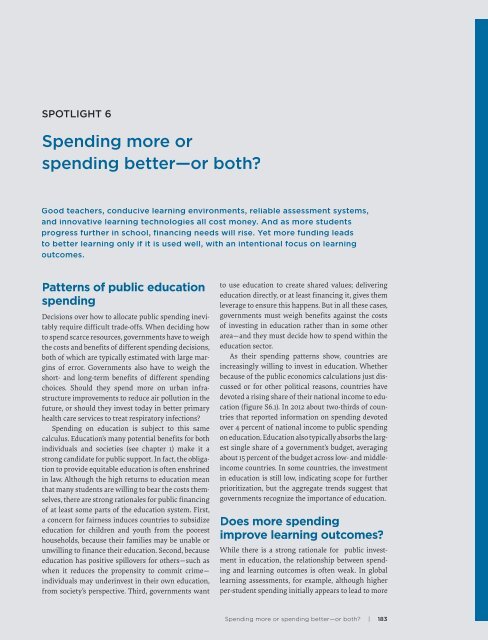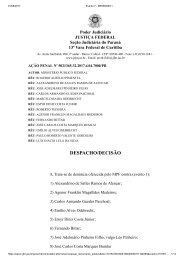Brasil só deve dominar Leitura em 260 anos, aponta estudo do Banco Mundial Relatorio Banco Mundial _Learning
You also want an ePaper? Increase the reach of your titles
YUMPU automatically turns print PDFs into web optimized ePapers that Google loves.
SPOTLIGHT 6<br />
Spending more or<br />
spending better—or both?<br />
Good teachers, conducive learning environments, reliable assessment syst<strong>em</strong>s,<br />
and innovative learning technologies all cost money. And as more students<br />
progress further in school, financing needs will rise. Yet more funding leads<br />
to better learning only if it is used well, with an intentional focus on learning<br />
outcomes.<br />
Patterns of public education<br />
spending<br />
Decisions over how to allocate public spending inevitably<br />
require difficult trade-offs. When deciding how<br />
to spend scarce resources, governments have to weigh<br />
the costs and benefits of different spending decisions,<br />
both of which are typically estimated with large margins<br />
of error. Governments also have to weigh the<br />
short- and long-term benefits of different spending<br />
choices. Should they spend more on urban infrastructure<br />
improv<strong>em</strong>ents to reduce air pollution in the<br />
future, or should they invest today in better primary<br />
health care services to treat respiratory infections?<br />
Spending on education is subject to this same<br />
calculus. Education’s many potential benefits for both<br />
individuals and societies (see chapter 1) make it a<br />
strong candidate for public support. In fact, the obligation<br />
to provide equitable education is often enshrined<br />
in law. Although the high returns to education mean<br />
that many students are willing to bear the costs th<strong>em</strong>selves,<br />
there are strong rationales for public financing<br />
of at least some parts of the education syst<strong>em</strong>. First,<br />
a concern for fairness induces countries to subsidize<br />
education for children and youth from the poorest<br />
households, because their families may be unable or<br />
unwilling to finance their education. Second, because<br />
education has positive spillovers for others—such as<br />
when it reduces the propensity to commit crime—<br />
individuals may underinvest in their own education,<br />
from society’s perspective. Third, governments want<br />
to use education to create shared values; delivering<br />
education directly, or at least financing it, gives th<strong>em</strong><br />
leverage to ensure this happens. But in all these cases,<br />
governments must weigh benefits against the costs<br />
of investing in education rather than in some other<br />
area—and they must decide how to spend within the<br />
education sector.<br />
As their spending patterns show, countries are<br />
increasingly willing to invest in education. Whether<br />
because of the public economics calculations just discussed<br />
or for other political reasons, countries have<br />
devoted a rising share of their national income to education<br />
(figure S6.1). In 2012 about two-thirds of countries<br />
that reported information on spending devoted<br />
over 4 percent of national income to public spending<br />
on education. Education also typically absorbs the largest<br />
single share of a government’s budget, averaging<br />
about 15 percent of the budget across low- and middleincome<br />
countries. In some countries, the investment<br />
in education is still low, indicating scope for further<br />
prioritization, but the aggregate trends suggest that<br />
governments recognize the importance of education.<br />
Does more spending<br />
improve learning outcomes?<br />
While there is a strong rationale for public investment<br />
in education, the relationship between spending<br />
and learning outcomes is often weak. In global<br />
learning assessments, for example, although higher<br />
per-student spending initially appears to lead to more<br />
Spending more or spending better—or both? | 183








